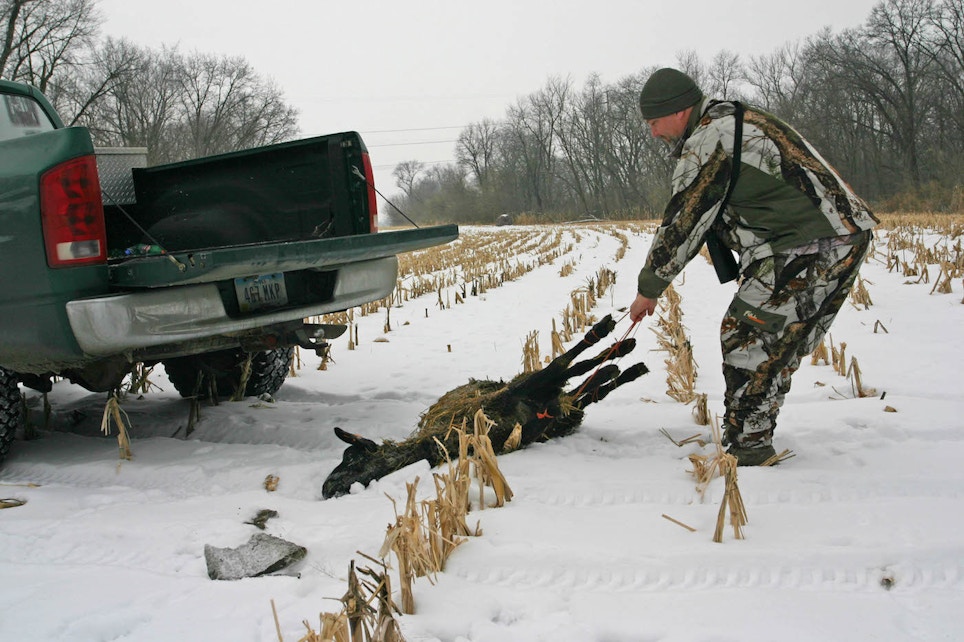At even a quarter-mile or so away, my 45X Nikon spotting scope clearly showed a bedded coyote firmly held in place by a short-chained No. 3 coil spring trap, 30 yards down a ridgetop cow path from where a second coyote was plainly visible hanging motionless from a snare. Patience when dealing with early season predators is never time wasted and it was 15 minutes before I caught a movement at the edge of a small clearing in the scattered oakbrush covering the knoll and slopes that revealed a third coyote as it appeared and just as quickly disappeared.
I’d found this spot earlier, when I checked to see what was attracting a flock of vociferous ravens and magpies flitting in and out an of oak brush thicket. There I found the remains of a coyote ravaged cow elk that had died from an arrow wound. It wasn’t in an ideal ambush location, where I could glass from a distance and if and sneak closer for a shot if I spotted any coyotes — a tactic that had put a lot of fur in my shed over the years.
Even though it was early in the season, I wasn’t about to pass up such an opportunity and by dark that evening I had placed several dirt hole and scent sets within smelling distance of the carcass and several snares on the most obvious trails.
Spotting the third coyote kicked me into predator hunting mode and I eased the truck back out sight, unlimbered my Kimber .22-250 Rem. and sneaked to the top of the adjacent downwind slope. From there I sneaked into a shadowed nook where I set up overlooking the draw between me and the unaware trapped coyote and mouthed my Weem’s Wildcall. My first series of panic stricken, high-pitched kyy-yiis and squeals brought the third coyote off the slope on the run. When he bounced to a stop at 50 yards to try and pinpoint the exact source of the sounds, a 52-grain HPBT made the stop permanent. Not a bad way to start an early fall predator venture.
Over the many years I’ve been an ardent predator hunter, caller, trapper and fur buyer, I have always been amazed when I talk with predator pursuers who limit their quest for critters to a single method such as trapping, calling, tracking and trailing, spot-and-stalk hunting, utilizing hounds or chase dogs, etc. — with many further limiting their endeavors to specific times of the year either by choice or regulations. Studies show that to have an impact on canine predator populations, 70 percent of those critters must be harvested for five years and that ain’t ever gonna happen these days. Narrow mindedness regarding predator hunting methods will do nothing but cut into your success.
Several years back, I was on a firearms company sponsored predator hunt in Alberta, Canada, where the coyotes and foxes were gorgeously furred and very calleable. One of our guides took me to the far side of a cattle feeder operation and we called in and killed a pair of coyotes on the periphery of the property. He showed me where the rancher dumped dead critters in a draw on a slope across from the feed pens. He said he had killed four or five coyotes on the huge spread during the year, but they only fed on the carcasses at night and were very call shy.
We took a tour of the property and I pointed out that if it was my hunting grounds, I would make a deal with the landowner to haul the carcasses to a couple of different ambush locations where he could glass them unobtrusively from a distance then sneak in and call them or simply ambush them on the carcasses.
He took my advice, and the first year his success jumped from five to 19 coyotes and four foxes. The next year, the rancher lined him up with neighbor and he added another 20 or so coyotes and a couple more foxes to his fur collection. The second rancher claimed his calf depredation losses dropped considerably due to the hunter’s predator decimating efforts. Great public relations.
A small ad in the local newspaper proclaiming your willingness to help farmers or ranchers with their predator problems might just be the ticket to expanding your predator hunting opportunities all year long. Such an endeavor can provide new predator challenges and give you a reason to expand your predator hunting knowledge, might put a few dollars in your pocket or more importantly, open additional hunting opportunities. Don’t knock it ’til you’ve tried it!






